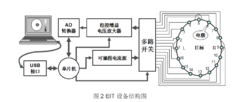动态电阻抗断层成像(Dynamic Electrical Impedance Tomography,d-EIT) 又称为EIT相对成像(Relative EIT),它以人体内部电导率的分布变化为成像目标,目前大多数商业系统和研究采用这种成像方式。进行动态EIT成像时,常选取某一时刻的数据作为参考帧,然后将当前时刻的数据作为测量帧与参考帧数据相减进行差分成像,以此来求出一个最优解反映测量帧时刻相对参考帧时刻的电导率的分布变化。通过差分的形式,可有效降低边界形状、电极位置、接触阻抗、系统噪声等测量误差对图像重构的影响。由于动态EIT图像重构时,不需要进行迭代计算,因此成像速度快,可以及时反映组织阻抗的变化。
由于该方法未使用核素或射线,对人体无害,因此可以多次测量重复使用,且成像速度快,具有功能成像等特点,加之其成本较低,不要求特殊的工作环境,因此EIT是一种理想的、具有诱人应用前景的无损伤医学成像技术,在20世纪末迅速成为研究热点,目前,一些商用的电阻抗断层成像设备已在临床开展应用。
1.基本原理大多数EIT系统采用的都是如图1所示的测量方式,数字1-16所标示的为粘贴在人体表明的电极,EIT硬件系统先在电极1-2处施加一激励电流,并在3-4,4-5,……,15-16处测得其电压,然后切换激励电极,改在2-3处施加一激励电流,并在其余的电极处测得对应的电压,激励电极切换一圈后,在其他电极处所测到的所有数据为一帧数据,通过测量两帧不同时刻的数据,重构出这两个时刻的电阻抗分布的变化。

图1 EIT测量示意图
电流激励时,如图 1所示,从相邻两个电极进行电流激励的方式称为邻近激励,从相对两个电极(如1-9电极)进行电流激励的方法称为对向激励,由于不同电流激励方式会在内部产生不同的电场分布,从而会影响EIT信号的检测能力和图像的重构质量。
2.设备组成EIT系统的结构如图2所示,由电流源、多路开关、电压放大器、AD转换器、单片机等共同组成。

图2 EIT设备结构图
电流源基于数字合成技术设计而成,由控制及接口模块、程控时钟发生器、存储单元、地址信号发生器、数模转换器、平滑滤波器、电压电流转换器共同组成。其工作原理是:在微程序控制器控制下,现场可编程逻辑器件中的时钟控制接口设置好时钟的频率,所产生的时钟信号被送往计数器,计数结果作为寻址信号被送往存储单元,从而使存储单元周期性地输出数字量。这些数字量是对一个周期正弦信号的点等间隔采样值,它们被依次送往DAC,再经平滑滤波后便可合成正弦波信号。此信号经电压电流转换器形成激励信号。
由于EIT数据采集过程中,需依次从多个电极中选取一对作为激励电极,并依次选取一对相邻电极进行测量。为适应不同激励测量模式的要求,数据采集系统应具备从这多个电极中任选两个进行激励,同时任选两个进行测量的能力。可采用多路多选1模拟电子开关构成了多路开关模块。多路电子开关中的两路的公共端分别与恒流源输出的正负极相联,另两路的公共端则分别与测量通道的同相和反相输入端相联。
电压测量模块需有高精度、低噪声、宽动态范围和宽频带等特性。为满足这些要求,电压测量模块主要由仪表放大器加程控增益放大器两大部分构成。
由于解调模块采用数字解调方式,需要在一个信号周期内对被测信号进行多次采样,因而所选AD转换器应具有较高的转换速度和较高的转换精度。
3.图像特点原始EIT图像显示的是按有限元剖分单元绘制的各单元上的阻抗相对变化值,原始EIT图像可以经过进一步的插值平滑处理成由一定数目不同伪彩色表示的像素矩阵,如图3所示。相对于CT、MRI图像而言,EIT图像分辨率较低,通常为32×32、64×64、128×128像素不等。

图3 正常人肺部EIT图像
EIT图像的不同颜色反映的是组织或器官相对阻抗变化,阻抗变化越大,图像对应区域的颜色变化越深。虽然EIT图像空间分辨率较低,但是阻抗分辨率非常高,在较好硬件系统支持下,可以对阻抗变化0.1%的目标进行成像。EIT成像的这一特点,使得它具有对微弱病变敏感,可早期发现病情的特点。
EIT图像另一重要特点是成像速度快,通过对重构矩阵的预先计算,EIT图像可以做到实时成像(25帧/秒以上),加之技术本身的无创无害,因此不仅可以对呼吸等快速变化进行实时成像,还能进行长时间的图像监测。
虽然EIT图像值目前还没有国际统一单位,仍采用相对变化值(Arbitrary Unit),但是针对不同的临床应用,已经提出了感兴趣变化、全局变异系数等许多成像指标,有些指标已成功指导临床的疾病诊治。
4.优势缺点(1)优势EIT图像属于功能图像,具有灵敏度高、安全性好、成本低廉、连续成像等优势,可以观察到疾病的早期变化,可以持续对功能及病情变化进行评估。
(2)缺点EIT图像分辨率较低,干扰较大时会引入伪影。
5.医学应用与发展前景电阻抗断层成像技术,特别是动态电阻抗断层成像技术,已经展现出了良好的应用前景,主要集中在:乳腺癌检测成像、腹部脏器功能成像、肺部呼吸功能成像、脑部功能成像等。由于临床应用需求不同,面临的技术难点也不同,EIT在上述领域的临床应用研究的成熟度也不同,有的应用点已经获得了产品认证,有的仍处于实验室研究阶段。但总的来说,近年来EIT技术越来越受到临床研究人员的关注。
(1) 乳腺癌检测成像乳腺癌是临床常见肿瘤,若发现于早期,则治愈率高,预后较好。又由于肿瘤组织具有电特性,特别是恶性肿瘤组织的电特性与周围正常组织的电特性存在明显区别,因此乳腺癌检测是电阻抗成像领域关注的重点方向之一, 研究结果表明,EIT、X线钼靶、超声总体敏感性没有显著性差异,EIT可以成为X线钼靶和超声的有力补充, EIT结合已有技术可以提高乳腺癌早期小肿瘤的检出率。
(2) 腹部脏器功能成像在腹部脏器功能成像研究领域有望成功应用的研究主要为腹腔内出血监测和胃动力监测。利用电阻抗成像技术已成功监测小猪腹膜内和腹膜后出血,并由临床应用个案报道。
(3) 肺部呼吸功能成像呼吸是人体重要的生命体征之一。由于空气不导电,因此呼吸时肺部会发生较大的电特性变化,加之呼吸具有特殊的周期性时域特性,因此电阻抗成像技术在肺部病情监测中的应用研究最为广泛,临床成熟度也最高。肺部电阻抗成像在人工通气、局部肺栓塞、局部肺灌注等领域都具有较好的临床应用前景
(4) 脑部功能成像由于脑科学研究的前沿性和脑血管疾病发生的致命危害性,因此进行颅脑电阻抗成像的相关研究具有非常重要的理论价值和应用价值。但由于颅骨具有非常大的电阻率,且在颅骨与脑实质之间又存在电阻率非常小的脑脊液层,这种空间结构上电阻率的巨大差异使得激励电流难以穿透颅骨,脑实质内的病变反映到皮层的信号发生较大衰减,使得颅脑电阻抗成像成为这个领域最富挑战性的难题。在脑部成像方面,已经在出血和缺血性脑卒中动物模型上获得了稳定的成像结果,完成了硬膜下血肿钻孔引流术监测,并进一步在脑水肿病人甘露醇脱水监测等方面取得了临床应用。
总之,EIT成像技术在临床的定位并不是取代CT、MRI等现有影像诊断技术,而是利用灵敏度高、安全性好、成本低廉、连续成像等优势,弥补现有影像技术的不足,作为现有技术的有力补充,提高临床诊治能力。
扩展阅读[1] Panagiotis K, Montaserbellah A, Panos L.Stimulation and measurement patterns versus prior information for fast 3D EIT: A breast screening case study[J]. Signal Processing, 2013, 93(10):2838-2850.
[2] Zou Y,Guo Z.A review of electrical impedance techniques for breast cancer detection[J].Medical Engineering & Physics,2003,25(2):79-90.
[3] Sachin P N, Houserkova D, Campbell J. Breast imaging using 3D electrical impedance tomography[J]. Biomedical Papers-Olomouc, 2008, 152(1):151-154.
[4] Raneta O, Bella V, Bellova L, et al. The use of electrical impedance tomography to the differential diagnosis of pathological mammographic/sonographic findings[J]. Neoplasma, 2013, 60(6):647-654.
[5] Forsyth J, Borsic A, Halter R J,et al. Optical breast shape capture and finite-element mesh generation for electrical impedance tomography[J]. Physiological Measurement, 2011, 32(7):797-809.
[6] Shuai W J, You F S, Zhang W, et al. Image monitoring for an intraperitoneal bleeding model of pigs using electrical impedance tomography[J]. Physiological Measurement, 2008, 29(2):217-225.
[7] Shuai W J, You F S, Zhang H Y, et al. Application of electrical impedance tomography for continuous monitoring of retroperitoneal bleeding after blunt trauma[J]. Annals of Biomedical Engineering, 2009, 37(11):2373-2379.
[8] You F S, Shi X T, Shuai W J, et al. Applying electrical impedance tomography to dynamically monitor retroperitoneal bleeding in a renal trauma patient[J].Intensive Care Medicine, 2013, 39(6):1159-1160.
[9] Maximilian S S, Viktoria W, Bea B, et al. Electrical impedance tomography during major open upper abdominal surgery: a pilot-study[J]. BMC Anesthesiology, 2014, 14:51.
[10] Sarker S A, Mahalanabis D, Bardhan P K, et al. Noninvasive assessment of gastric acid secretion in man—application of electrical impedance tomography (EIT)[J]. Digestive Diseases and Sciences, 1997, 42(8):1804-1809.
[11] Pavel D, Anatolij T, Josef P, et al.Assessment of regional ventilation with the electrical impedance tomography in a patient after asphyxial cardiac arrest[J].Resuscitation, 2014, 85(8):115-117.
[12] Zhao Z, Fischer R, Frerichs I, et al.Regional ventilation in cystic fibrosis measured by electrical impedance tomography[J]. Journal of Cystic Fibrosis. 2012, 11(5):412-418.
[13] Karsten J, Bohlmann M K, Sedemund-Adib B, et al.Electrical impedance tomography may optimize ventilation in a postpartum woman with respiratory failure[J].International Journal of Obstetric Anesthesia, 2013, 22(1):67-71.
[14] Patricia B, Michael M, Helmut H, et al.Imaging of local lung ventilation under different gravitational conditions with electrical impedance tomography[J].Acta Astronautica, 2007, 60(4): 281-284.
[15] Suchomel J, Sobota V. A model of end-expiratory lung impedance dependency on total extracellular body water[C]// XIV Conference on Electrical Impedance Tomography. Heilbad Heiligenstadt, Germany: IOP Publishing, 2013:1-4. .
[16] Ferrario D, Grychtol B, Adler A,et al.Toward morphological thoracic EIT: major signal sources correspond to respective organ locations in CT[J]. IEEE Transactions on Biomedical Engineering, 2012, 59(11):3000-3008.
[17] Holder D S. Feasibility of developing a method of imaging neuronal-activity in the human brain—a theoretical review[J]. Medical & Biological Engineering & Computing, 1987, 25(1):2-11.
[18] Gilad O, Holder D S. Impedance changes recorded with scalp electrodes during visual evoked responses: implications for electrical impedance tomography of fast neural activity[J]. Neuroimage. 2009, 47(2):514-522.
[19] Vongerichten A, Santos G, Avery J, et al. Electrical impedance tomography (EIT) of epileptic seizures in rat models-a potential new tool for diagnosis of seizures[J]. Clinical Neurophysiology. 2014, 125(S1): S282-S283.
[20] Shi X T, Dong X Z, Shuai W J, et al. Pseudo-polar drive patterns for brain electrical impedance tomography[J]. Physiological Measurement, 2006, 27(11):1071-1080.
[21] Ni A S, Dong X Z, Yang G S, et al. Image reconstruction incorporated with the skull inhomogeneity for electrical impedance tomography[J]. Computerized Medical Imaging and Graphics, 2008, 32(5):409-415.
[22] Xu C H, Dai M, You F S, et al. An optimized strategy for real-time hemorrhage monitoring with electrical impedance tomography[J]. Physiological Measurement, 2011, 32(5):585-598.
[23] Dai M, Li B, Hu S J, et al. In vivo imaging of twist drill drainage for subdural hematoma: a clinical feasibility study on electrical impedance tomography for measuring intracranial bleeding in humans[J]. Plos One, 2013, 8(1):10.
[24] Xu C H, Wang L, Shi X T, et al. Real-time imaging and detection of intracranial haemorrhage by electrical impedance tomography in a piglet model[J]. Journal of International Medical Research, 2010, 38(5):1596-1604.
[25] Fu F, Li B, Dai M, et al. Use of electrical impedance tomography to monitor dehydration treatment of cerebral edema: a clinical study[C]// 15th International Conference on Biomedical Application of Electrical Impedance Tomography.Ontrario, Canada: IOP Publishing, 2014:5.
[26] Li J B, Tang C, Dai M, et al. A new head phantom with realistic shape and spatially varying skull resistivity distribution[J].IEEE Transactions on Biomedical Engineering, 2014, 61(2):254-263.
[27] Xu S W, Dai M, Xu C H, et al. Performance evaluation of five types of Ag/AgCl bio-electrodes for cerebral electrical impedance tomography[J].Annals of Biomedical Engineering,2011, 39(7):2059-2067.
[28] Dai M, Wang L A, Xu C H, et al.Real-time imaging of subarachnoid hemorrhage in piglets with electrical impedance tomography[J]. Physiological Measurement, 2010, 31(9):1229-1239.
本词条内容贡献者为:
徐灿华 - 讲师 - 第四军医大学生物医学工程学院董秀珍 - 教授 - 第四军医大学生物医学工程系




 扫码下载APP
扫码下载APP

 科普中国APP
科普中国APP
 科普中国
科普中国
 科普中国
科普中国